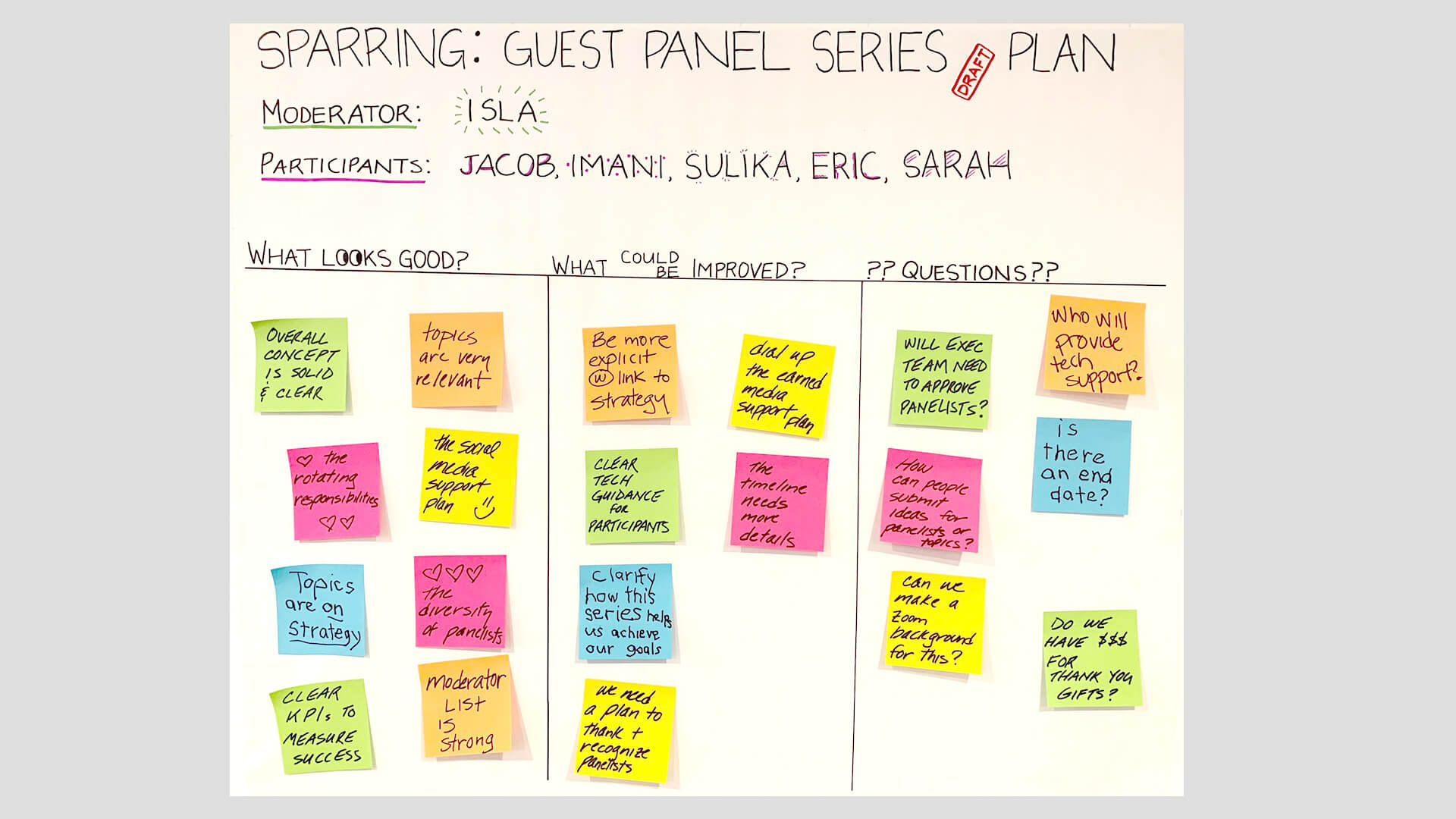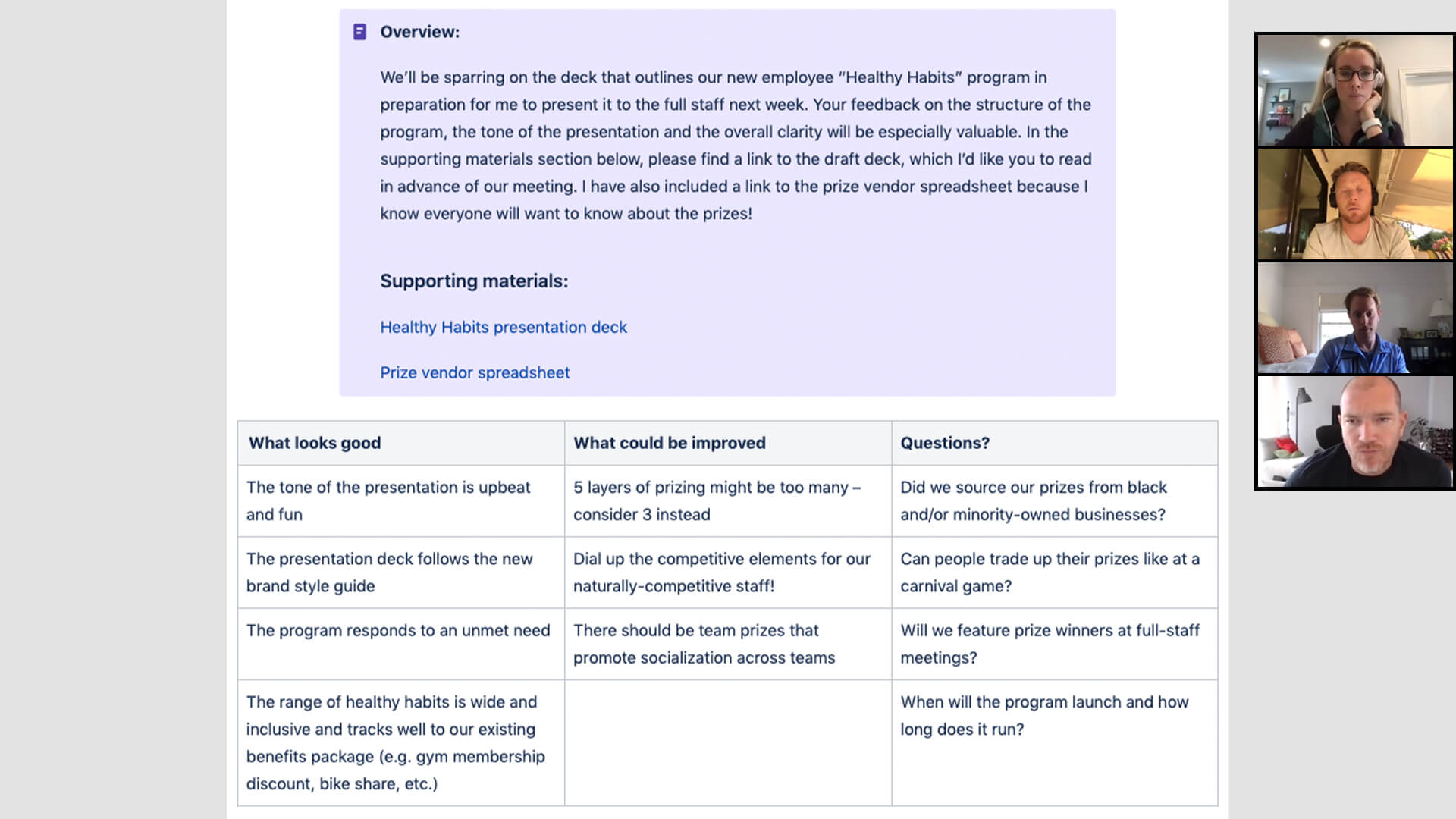Sparring
Sparring is a way of getting feedback that helps move your work forward without making anyone feel uncomfortable or hurt.

PREP TIME
15m
Run TIME
30m
Persons
2-5
5-second summary
- Share ideas and drafts of your work with teammates and stakeholders.
- Get fast, candid feedback on what’s strong, what could be improved, and what’s unclear.
- Improve your work and your relationship with collaborators.
WHAT YOU WILL NEED
- Meeting space or video conferencing with screen sharing.
- Digital collaboration tool (see templates).
- Optional: physical whiteboard, markers, sticky notes, and timer.
PLAY resources
How to use sparring for peer feedback
Get quick, honest feedback from colleagues in a structured, safe setting.
What is sparring?
In the world of teamwork, sparring has nothing to do with fighting, so you can put those boxing gloves away. Instead, sparring is a way of getting feedback at work in a way that helps move your work forward without making anyone feel uncomfortable or hurt in the process.
Why run the Sparring Play?
While the idea of peer feedback might seem scary – both for the giver and the receiver – it’s a crucial part of elevating processes, workflows, deliverables, and team relationships. Use the Sparring Play to ensure the peer feedback you get is topical, diverse, and given in a psychologically safe environment.
When should you use sparring?
Sparring can be done anytime you or a teammate has an idea or draft they want feedback on. You can also build a culture of frequent feedback by putting a standing sparring session on the calendar each week, where team members can sign up to share their work.
What are the benefits of feedback while sparring?
Research shows team members benefit from both giving and receiving feedback while sparring:
- Improve performance
Feedback interventions generally improve performance, particularly when the feedback is focused on specific tasks (rather than the person themselves) and is delivered in a constructive way. - Build psychological safety
Psychological safety enables and is strengthened by honest feedback exchanges. Teams with higher levels of psychological safety were more likely to seek and provide insights, creating a positive cycle where trust and feedback mutually reinforce each other. - Increase learning
While it might be surprising, research shows that providing feedback can lead to even more learning than receiving it. - Boost creativity
Seeking feedback has been proven to help people adapt and improve their creativity.
1. Prep the Play
Est. time: 15 MIN
Send attendees the work you’d like feedback on, along with any other supplementary information, before the meeting. If possible, also provide your sparring team with previous peer feedback examples to give them a frame of reference.
Then, create a new collaboration document, such as a Confluence page or Trello board, to house feedback. For in-person meetings, it’s also helpful to print out the content you’d like to spar about. Increase the size by 2x or 3x for easier reading and markup.
Tip: FRESH PERSPECTIVES
Invite a mix of people who are familiar with your work and those who aren’t to get diverse suggestions.
2. Set the stage
Est. time: 5 MIN
Start the meeting by:
- Describing what you’re working on, along with an overview of your goals, requirements, audience, and any other background information or context that would help inform their feedback
- Explaining why you’re looking for feedback and how you’ll use it
- Outlining the areas you’re looking for feedback on (and areas you aren’t)
- Sharing tips on how to give honest, constructive peer feedback
Tip: GIVE EXAMPLES
If you have them on hand, quickly share an example or two of good peer feedback to give attendees a basic idea of what you’re looking for.
3. Gather feedback
Est. time: 10 min
Set a timer for 10 minutes. Have attendees review your work, compare it to the background context you provided, and add feedback. (You can choose whether to do this out loud or quietly.)
Feedback could include strengths, suggested edits, anything they’d recommend removing, or questions they have. Encourage them to mark up the work using digital tools, such as a Confluence page or whiteboard, or in person with markers, sticky notes, and comments.
When giving peer feedback, acknowledge the positives and provide specific recommendations for improving the work. Positive feedback and constructive criticism help foster a safe environment for discussion and increase the likelihood of team members reaching out for more feedback in the future.
Tip: THE SOUND OF SILENCE
Silent writing provides space to think and gather input from quieter team members. It keeps the focus on providing honest, actionable peer feedback instead of discussion.
4. Discuss
Est. time: 10 min
As you review the notes, identify any recurring themes, and discuss your understanding of the peer feedback you've received to ensure you all agree on its meaning.
Discuss your reasoning behind your work choices and be open to the team's new ideas for improvement.
Tip: DON’T TAKE IT PERSONAL
Receiving a lot of critical feedback can be tough. Remember that getting feedback at work isn’t personal. This is about improving your work with people who want to help.
5. Wrap up
Est. time: 5 min
Close the session by thanking attendees for their participation and perspectives. Let them know the next steps you’ll take with your work and when they can expect to hear back on your next iteration.
Tip: MAKE IT A HABIT
Build a culture of frequent feedback by scheduling a standing sparring session each week, where team members can sign up to share their work.
Follow-up
Review the feedback
After the Play, take some time on your own to organize and review the team’s feedback. Sometimes you won’t have time to discuss all of the peer feedback you received during the sparring session, so use this time to identify exactly what suggestions you’ll be incorporating. Follow up with attendees if you have any questions.
Round 2
Once you’ve incorporated the feedback, consider scheduling a second sparring session to further refine your work.
Variations
Leave the room
During the feedback-gathering portion of the sparring session, have the presenter leave the room. This allows attendees to focus on writing feedback rather than engaging in discussion with the presenter. It will also make them feel more comfortable providing peer feedback that may involve constructive criticism.
If you're meeting virtually, have the presenter leave the meeting temporarily to allow attendees the time and space to provide feedback without distraction or discussion. Then, invite the presenter back to share and discuss.

Still have questions?
Start a conversation with other Atlassian Team Playbook users, get support, or provide feedback.
Other plays you may like
Meetings
Weekly Team Updates
Share how things are going—without scheduling another meeting.
Meetings
Page-Led Meetings
Better meetings start with a page that outlines the purpose, expected outcomes, and key discussion points.
Communication
User Manual
Help your teammates understand how best to work with you.
Debrief
Retrospective
Provide a safe space to discuss what worked and what didn’t.
Stay up to date
Get the latest Plays and work life advice when you sign up for our newsletter.









